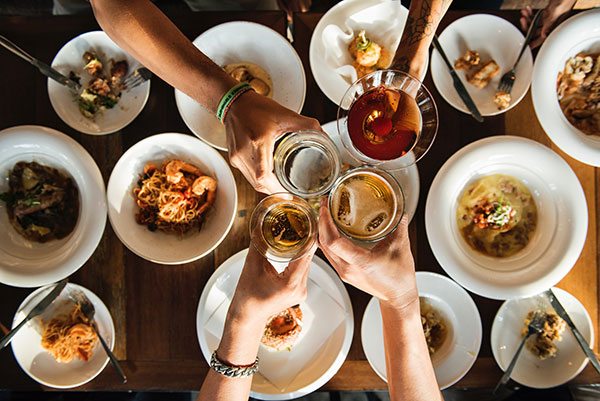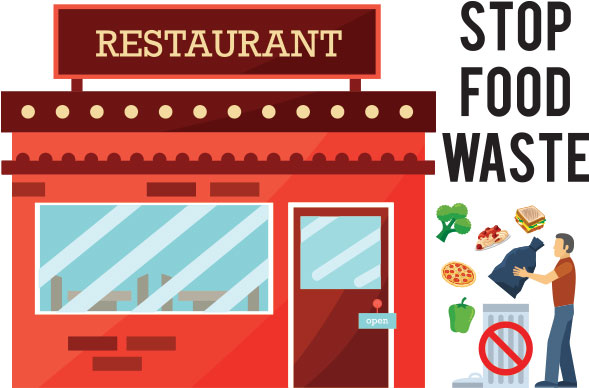Restaurant owners–how many times have you seen these things happen and had feelings of frustration because of the waste of food?
As business owners, rest assured that most of you have probably had a combination of these experiences. However, there is a new trend that is gaining popularity in the food industry that is eliminating the amount of food we waste at our restaurants.
According to the Food and Agriculture Organization of the United Nations, approximately 1.3 billion tons is wasted. This amounts to about $680 billion lost. As a restaurant owner, it is clear the impact numbers like this can have on your business present and future. While there is no way to predict the future of the industry, there are preventative measures that can be taken to ensure that your business does not contribute to this massive amount of waste and financial loss: keep up with the trends.
Offering small bites and shared portions is a great way to reduce the amount of food wasted per year and leave your customers feeling satisfied rather than stuffed. In this blog, we will explore the cultural impact on this trend, how it plays into health-conscious customers’ preferences and how business owners, like yourself, can incorporate this trend into their regular service offerings. Read on to see how this trend is shaping the strategy of food industry leaders.
Government Regulations and Healthcare Cost
When we examine the role that the government could have in regard to restricting portion size, the argument is complex. On one hand, the idea of the government placing regulations on individual restaurants seems nearly impossible. For large chain restaurants it would be much easier and traceable, but for smaller eateries, it may be more challenging. Not only that but it would certainly induce anxiety and require additional training for the kitchen staff to ensure they understand the regulations and know how to adhere to them.
Conversely, the government is already paying attention to laws around food and consumption in our country. The FDA and the USDA Center for Nutrition Policy and Promotion are the most obvious examples. In regard to educating America about the importance of a balanced diet, there have been initiatives such as MyPlate that have caught on, particularly in schools. Initiatives like this were created in response to the obesity problem in the country. The CDC reported that, from 2015-2016, obesity impacted about 93.3 million adults. In 2008, the estimated annual medical cost of obesity in the United States was $147 billion and the numbers have only worsened over the years. The government has yet to actually impose laws regulating portions in restaurants, but, in looking at these statistics, it may just be a matter of time.
In Canada, the government is heavily involved in the regulation of food as well. Recently, they have enacted the SFCA (The Safe Food for Canadians Act) and the SFCR (Safe Food for Canadians Regulations). While these laws may not directly relate to appropriate portions or consumption in general, it shows that Canada is both aware and involved in the food industry. Additionally, programs such as EatRightOntario and Dieticians of Canada, educate consumers about appropriate serving sizes through various online resources, making this information significantly more accessible.
Why Does This Matters to Your Health Conscious Customer?

This is an era of young and millennial customers. The health-conscious customer appreciates small bites or the option for shared portions not only because of cost, but because it aligns with the time-old philosophy of “moderation”. Anyone who is on a health-conscious diet is going to be tempted by but ultimately shy away from a 3-pound plate of chicken parmesan with linguine and a bucket of unlimited breadsticks.
Customers are more likely to indulge in a dish like that when they have an option to share the meal or it comes in smaller portion size. More likely than not, these health-conscious customers have been measuring their food intake to match the suggested serving size (something that we all too often ignore). Help them out a little by offering dishes at your restaurant that adhere to these guidelines as well. Not only are you showing consciousness of appropriate serving sizes and pleasing your customers, but you’re eliminating potential waste of food that these customers will end up not eating anyway.
While taking into consideration the needs of your health-conscious customers are certainly important, it is equally as crucial to look at this from a business perspective as well. Not only will you be saving money on extra ingredients that will end up being wasted, but you are lessening your negative industry footprint in doing so. This becomes both environmentally and economically beneficial for your business. Not only that, but it shows an awareness of the challenges the industry faces and that your restaurant is taking action. Additionally, It can be a win-win marketing strategy for you to demonstrate shared values, care for the social cause and respect for the environment.
Specific Needs: Health and Belief Based

There is a multitude of reasons why people may lean towards the small bites or shared portions style of dining. These reasons are typically either health-based (i.e. customers are trying to reduce calorie intake or have a sensitivity such as gluten or lactose) or belief based (i.e. religious and moral beliefs that only allow certain foods in certain amounts to be eaten at a given time).
Millennial tend to believe in self-discipline and own the decisions related to their own health and wellbeing. Customers, who are watching their caloric intake or, more specifically, their cholesterol levels, sodium intake, etc. small bites rather than large meals give them the ability to try a variety of tasty foods while removing the option for them to eat to excess. For these people, it’s important to have a varied diet, but also keep track of their intake of nearly every ingredient. With this model, offering them just a “taste” of something is a great way to do that. Again, we see the word “moderation” coming into play in these types of situations.
Variety is Key
Taking a look at the “shared portions” side of this discussion, something European countries, specifically Italy, is known for is the “family-style” method of sharing a meal. This means that a family of several people will choose a few dishes and share them, rather than each ordering their own individual meal. This “family style” method has caught on in many parts of the world and many restaurants have begun using this style for large parties.
Variety is a key term here, specifically when we are talking about shared portions with large groups of people. It is recommended that we vary our diets for a multitude of reasons, such as balancing our macronutrients and simply keeping what we eat interesting and fresh. Oriental cuisine and food traditions are an excellent example of this. For instance, specifically in Chinese culture, most dishes are meant to be shared. Typically, each dinner guest will have their own rice or noodles as a foundation for the meal and a few main dishes will be placed in the center for all to share. Sometimes, guests will even eat out of one common dish but use separate utensils while doing so.
MenuSano’s Role
MenuSano nutritional analysis software has great value if you decide you want to implement this growing trend into your restaurant. Our user-friendly nutrition facts label software allows you to break down the nutritional content of all of your dishes and, you can share that information with your customers on your menu.
Not only is this useful for educating your customers about what is in the food they are ordering, but in this case specifically they are able to see how much healthier it is to eat in smaller “bites” or sharing meals rather than eating an entire one themselves. Some customers may not select this option right away, as it certainly takes some time to get used to this style, but as a restaurant owner in this competitive industry, it is important that you explore and experiment with all of these new ways of serving up your best dishes.
Start your free trial today by visiting MenuSano.com!



















